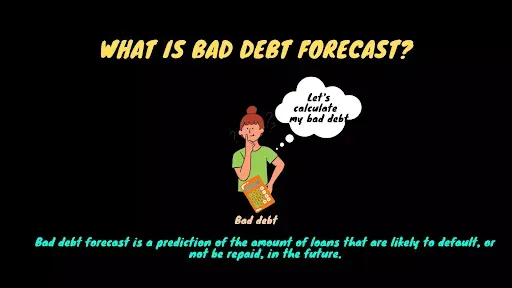What is Bad Debt Forecast?
Bad debt forecast is a prediction of the amount of loans that are likely to default, or not be repaid, in the future. This is an important consideration for lenders, as bad debt can have significant negative impacts on a financial institution's profitability and stability.
Factors Affecting Bad Debt Forecast
There are a number of factors that can contribute to a high bad debt forecast. The most common is the creditworthiness of the borrower. Lenders typically assess the creditworthiness of a borrower by looking at their credit score, income, and debt-to-income ratio. Borrowers with lower credit scores and higher levels of debt are more likely to default on their loans, and as a result, lenders may be more hesitant to extend credit to these individuals.
The economy can also play a role in bad debt forecast. During times of economic downturn, unemployment rates may rise and individuals may struggle to make ends meet, leading to an increased likelihood of default on loans. Similarly, if the value of the collateral used to secure a loan decreases significantly, the borrower may be more likely to default.
Methods for Forecasting Bad Debt
There are several steps that can be taken to develop a bad debt forecast:
Gather data: The first step in developing a bad debt forecast is to gather data on past loans and defaults. This may include information on the creditworthiness of the borrowers, the terms of the loans, and the performance of the loans over time.
Analyze the data: Once the data has been collected, it should be analyzed to identify any patterns or trends that may indicate the likelihood of default. This may involve using statistical modeling techniques, such as logistic regression or decision trees.
Identify risk factors: The next step is to identify the specific risk factors that are most predictive of default. These may include the creditworthiness of the borrower, the terms of the loan, and the economic environment in which the loan was made.
Estimate default rates: Based on the analysis of the data and identification of risk factors, default rates can be estimated for different types of loans.
Incorporate external factors: It is important to also consider any external factors that may impact the likelihood of default. These may include changes in government regulations or the introduction of new financial products.
Review and update the forecast: It is important to regularly review and update the bad debt forecast to ensure that it remains accurate and relevant. This may involve gathering additional data, refining the modeling techniques used, or incorporating new external factors into the forecast.
Conclusion
Overall, a bad debt forecast is a crucial tool for lenders, as it helps them to assess the risk of default on a particular loan and make informed lending decisions. By accurately forecasting bad debt, lenders can protect their profitability and stability, while also ensuring that they are able to meet the credit needs of their customers.


